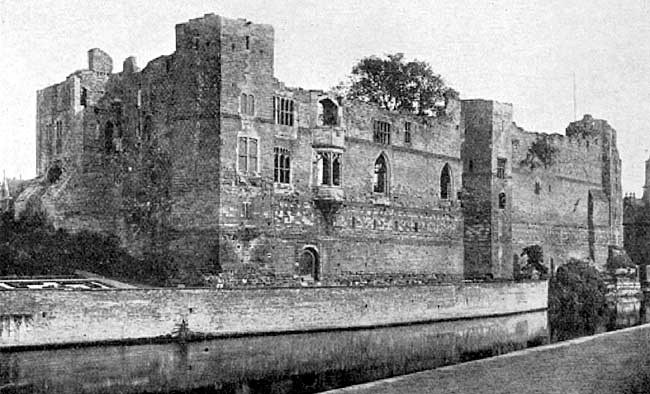< Previous | Contents | Next >
19. Architecture—(b) Military.
The traveller approaching Nottingham from the south or west is attracted by the sight of a stately mansion perched on a great rock which towers far above the tallest chimney-stacks. This building is quite modern, but its name—Nottingham Castle—is very ancient. Three centuries and a half ago the sight which would have met his eye would have been more like that shown in the picture of Nottingham Castle in the sixteenth century (p. 128). Then a typical mediaeval castle existed. Now all that remains of it are a few fragments of the foundations, and the barbican or fortified gateway shown in the front of the picture. This has been recently restored, but portions of the old stonework may still be seen peeping through the new covering. Formerly this gateway led into the outer bailey or courtyard, the site of which is now occupied by the lower grass-plots and flower-beds. On the opposite side of this yard was a bridge ending in a drawbridge across the moat, which still exists. Beyond was another gateway with a portcullis. To the right was the wall of the inner bailey or quadrangle, fortified with several bastions or round towers. That nearest the gateway had narrow openings through which archers might pour volleys of arrows upon an enemy who had gained the outer yard and was endeavouring to cross the bridge.
The inner bailey occupied the site of the present top lawn. On its north side was the great tower, which can be seen standing out against the sky in the background of the picture. This was erected by Edward IV and added to by Richard III. Its lower stages and spiral staircase still exist in neighbouring grounds. All the other parts of the castle were built before the time of Henry IV.
From the quadrangle an incline led up to the highest part of the rock. This is now occupied by the Art Museum, but then by the oldest part of the castle, the fortress built by William I in 1068. The entrance to this fortress had no portcullis. The space within was called the inner ward. From it a subterranean passage now known as Mortimer’s Hole led down to the foot of the rock. On the north side was the keep, a very characteristic feature of Norman fortresses. It was usually a strong rectangular building which served as the last resort when all the other parts were carried by the enemy, and it almost invariably had a well.
Such then was Nottingham Castle, a favourite resort of kings. Some idea of its importance may be gained by the fact that during its existence more Parliaments were held in it than at Westminster. It was at its best in the reign of Richard III. In common with other castles in the country it was systematically neglected by Henry VII and then began to fall into decay. At the close of the Civil Wars it was dismantled by Colonel Hutchinson. Some time after the Restoration it passed into the hands of the Duke of Newcastle, who preserved the outer gateway for use as a lodge but razed the remainder of the ruins to the ground. He then, at great cost, erected the present building as a residence. In 1831 all but the outer wall of this was destroyed by fire during the Reform Riots. In 1875 the site was leased to the Corporation of the City and the building was restored and converted into an Art Museum.

Newark Castle.
Newark also had a great castle, and fortunately considerable portions of it are still well preserved. It was commenced in 1130 by Bishop Alexander on the flat ground between the Devon and the Fosseway. The general plan seems to have been that of a keep on a large scale, rectangular in shape with a square tower at each corner. On the west it was protected by the river, on the other sides by a double moat. The entrance was on the north, and consisted of a barbican on the outer edge of the moat, a very strong gatehouse used as a keep on the inner edge, and a drawbridge between. The gatehouse, part of the adjoining wall, the lowest parts of the west wall, and the whole of the square south-west tower are all that remain of the Bishop’s Castle. Traces of typical Norman archways and windows may still be seen. These together with the building material, which was oolite, help to distinguish the bishop’s work from that of later date.
During the first quarter of the thirteenth century the castle was completed. Grey Lias limestone was used on the inside and red sandstone on the outside. The fine hexagonal tower at the north-west corner, a similar one in the middle of the west wall, and a Great Hall lighted by means of large pointed windows, were built at this time. In the fifteenth century the castle was used merely as a residence. To adapt it for this purpose the Great Hall was divided into two storeys having several rooms. Windows of late Perpendicular style and the beautiful oriel window which lighted the state room were also inserted.
Newark Castle was the focus of the Civil War, and soon after this it was allowed to fall into ruins.
The remnants of an old Castle known as King John’s Palace exist at Clipstone.
